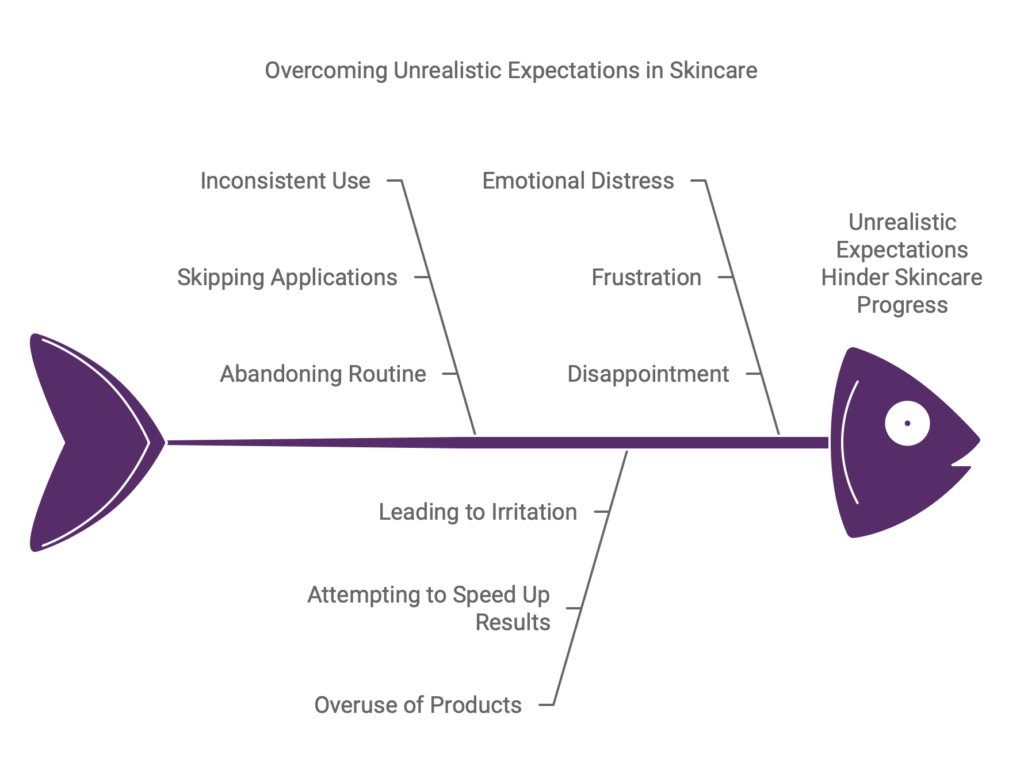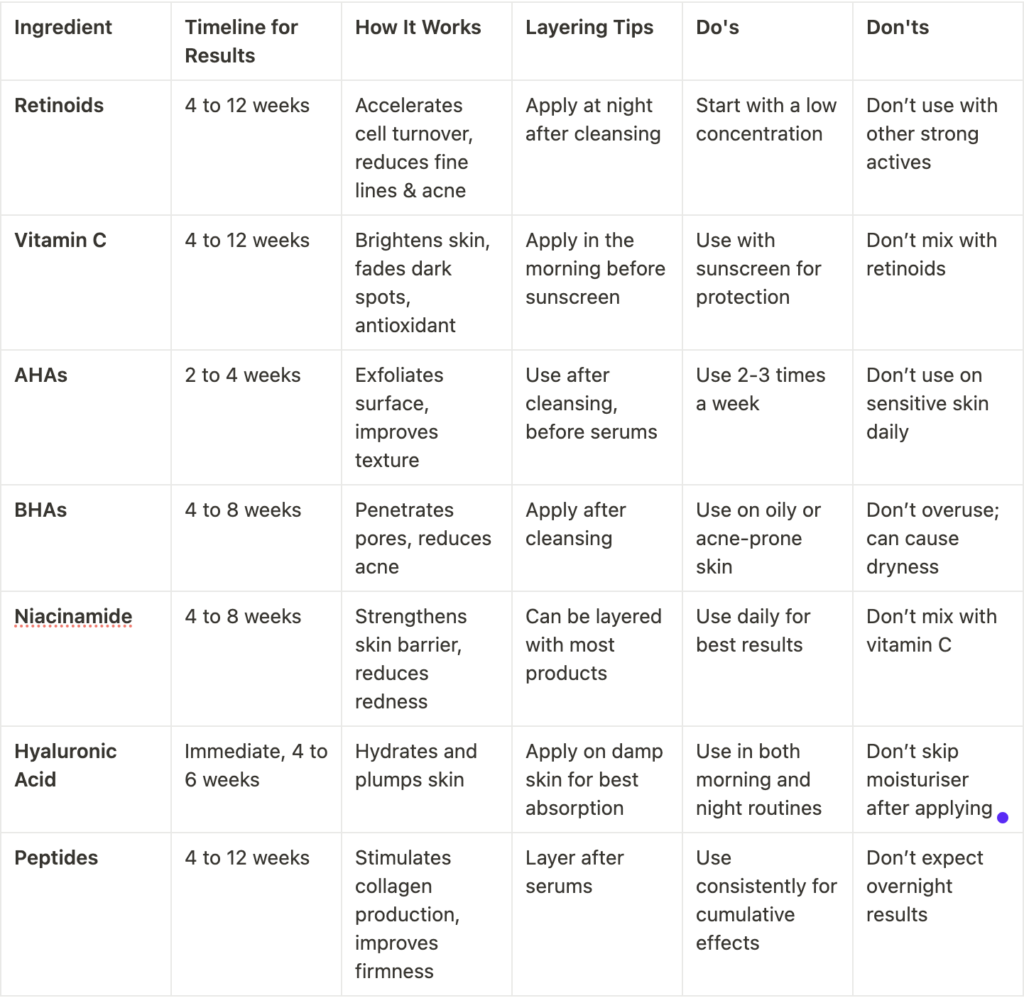
As we embark on a journey toward healthier skin in 2025, it’s crucial to set realistic expectations about what skincare can achieve and how quickly results can manifest. Many individuals, especially those struggling with skin issues, often seek instant results, leading to disappointment and inconsistency in their skincare routines. In this article, we’ll explore the science behind the skin renewal cycle, the timelines for various active ingredients, and the importance of patience and consistency in achieving your skin goals.
The Science of Skin Renewal
Understanding the skin’s renewal cycle is fundamental to setting realistic skincare timelines. The skin undergoes a natural process of cell turnover, where old skin cells are shed and replaced with new ones. For younger adults, this cycle typically takes about 28 days. However, as we age, this process slows down, extending the turnover cycle to 40 days or more.
This means that when you start a new skincare regimen, it may take several weeks before you notice visible improvements. While some products can provide immediate benefits—such as reducing redness or addressing surface-level acne—most active ingredients require time to work effectively.
The Impact of Unrealistic Expectations

When individuals expect instant results, they may become discouraged if they don’t see immediate changes. This disappointment can lead to inconsistent application of products, ultimately hindering progress toward their skin goals. Here are some common pitfalls of unrealistic expectations:
- Inconsistent Use: If results aren’t seen quickly, individuals may skip applications or abandon their routine altogether.
- Overuse of Products: In an attempt to speed up results, some may overuse products, leading to irritation or adverse reactions.
- Frustration and Disappointment: Unrealistic timelines can lead to emotional distress, especially for those who are already struggling with skin issues.
By understanding the science behind skin renewal and setting realistic expectations, individuals can maintain consistency in their routines and achieve their desired results.
How Long Do Active Ingredients Take to Work?
Different active ingredients have varying timelines for delivering visible results. Here’s a breakdown of some scientifically proven active ingredients and their expected timelines:

1. Retinoids
- Timeline: 4 to 12 weeks for noticeable improvements in texture, fine lines, and acne.
- How They Work: Retinoids accelerate cell turnover, promoting the shedding of old skin cells and the production of new ones.
2. Vitamin C
- Timeline: 4 to 12 weeks for brightening skin tone and reducing discoloration.
- How It Works: Vitamin C is an antioxidant that helps to fade dark spots and improve overall skin radiance.
3. AHAs (Alpha Hydroxy Acids)
- Timeline: 2 to 4 weeks for smoother texture and improved hydration.
- How They Work: AHAs exfoliate the surface of the skin, promoting cell turnover and revealing fresher skin underneath.
4. BHAs (Beta Hydroxy Acids)
- Timeline: 4 to 8 weeks for clearer pores and reduced acne.
- How They Work: BHAs penetrate deeper into the pores, helping to dissolve excess oil and prevent breakouts.
5. Niacinamide
- Timeline: 4 to 8 weeks for improved skin texture and reduced redness.
- How It Works: Niacinamide strengthens the skin barrier and regulates oil production, leading to a more balanced complexion.
6. Hyaluronic Acid
- Timeline: Immediate hydration, with longer-term benefits visible in 4 to 6 weeks.
- How It Works: Hyaluronic acid attracts moisture to the skin, providing instant hydration and plumping effects.
7. Peptides
- Timeline: 4 to 12 weeks for improved firmness and elasticity.
- How They Work: Peptides signal the skin to produce more collagen, enhancing skin structure and reducing the appearance of fine lines.
Factors Affecting Skincare Timelines
Several factors can influence how quickly individuals see results from their skincare routines:
- Skin Type: Oily, dry, or sensitive skin may respond differently to active ingredients.
- Age: As mentioned, the skin’s renewal cycle slows with age, affecting how quickly results are seen.
- Lifestyle Factors: Diet, hydration, stress levels, and sleep quality can all impact skin health and the effectiveness of skincare products.
- Consistency: Regular and consistent application of products is essential for achieving desired results.
How Long to Stick with a Skincare Routine
To see visible improvements for common skin issues, individuals should commit to their skincare routine for a minimum of 8 to 12 weeks. Here’s a general guideline for how long to stick with specific concerns:
- Texture Issues: 8 to 12 weeks for smoother skin with consistent use of exfoliating ingredients.
- Discolouration: 12 weeks or longer for fading dark spots and achieving an even skin tone.
- Firmness: 12 weeks for noticeable improvements in skin elasticity and firmness with the use of peptides and retinoids.
- Hydro-Lipid Balance: 4 to 8 weeks for improved hydration and balance with the use of hyaluronic acid and moisturisers.
The Key to Success: Patience and Consistency
Achieving your skin goals in 2025 requires a commitment to patience and consistency. Here are some tips to help you stay on track:
- Set Realistic Goals: Understand that skincare is a journey, and results take time. Set achievable milestones to keep yourself motivated.
- Track Your Progress: Use a skincare journal to document your routine, products used, and any changes you notice over time. This can help you stay accountable and recognise improvements.
- Stay Educated: Continuously learn about skincare ingredients and their effects. Knowledge empowers you to make informed decisions about your routine.
- Practice Self-Compassion: Be kind to yourself throughout the process. Skin issues can be emotionally challenging, so remember that progress takes time.
Achieve Your Skin Goals
As you embark on your skincare journey in 2025, remember that realistic skincare timelines are essential for achieving your goals. By understanding the science behind your skin’s renewal cycle and the expected timelines for active ingredients, you can set yourself up for success. Embrace patience and consistency, and you’ll be well on your way to healthier, more radiant skin. Here’s to making 2025 your best year yet in skin health and self-confidence!
Frequently Asked Questions
How long does it really take to see results from a new skincare routine?
Generally, you should expect to wait 8-12 weeks to see significant results from a new skincare routine, due to your skin’s natural renewal cycle. This cycle takes about 28 days in younger adults and can extend to 40+ days as we age. While some products like hyaluronic acid provide immediate hydration benefits, most active ingredients need several weeks to show visible improvements. Consistency is key—maintain your routine daily for the best results.
Why do retinoids and vitamin C take so long to show results?
Retinoids and vitamin C typically take 4-12 weeks to show noticeable results because they work at a deeper cellular level. Retinoids accelerate cell turnover and promote new cell production, while vitamin C gradually brightens skin tone and reduces discolouration by affecting melanin production. These ingredients require time to influence your skin’s natural processes and build up enough changes to be visible on the surface. Patience and consistent use are essential for seeing their full benefits.
What skincare ingredients work the fastest, and which ones take longer?
Hyaluronic acid offers the quickest results, providing immediate hydration within hours. AHAs (Alpha Hydroxy Acids) show improvements in skin texture within 2-4 weeks. However, ingredients targeting deeper concerns take longer: BHAs need 4-8 weeks for clearer pores, niacinamide requires 4-8 weeks for texture improvement, and peptides need 4-12 weeks for enhanced firmness. The timeline varies based on your skin type, age, and consistency of use.
How can I tell if my skincare routine is actually working?
Track your progress by keeping a skincare journal and taking regular photos under consistent lighting. Look for subtle changes first: improved hydration, reduced redness, or smoother texture. Major changes in concerns like discolouration or firmness typically take 8-12 weeks to become noticeable. If you’re using products correctly and consistently but see no improvements after 12 weeks, consult a skincare professional to adjust your routine.
Why do some people see results faster than others with the same products?
Results vary between individuals due to several factors: skin type (oily, dry, or sensitive), age (affecting cell turnover rate), lifestyle factors (diet, sleep, stress levels), and consistency of product application. Environmental factors and genetics also play significant roles. Someone with naturally faster cell turnover might see results sooner than someone with a slower renewal cycle. Focus on your personal progress rather than comparing timelines with others.
Is it normal to experience temporary skin issues when starting new products?
Yes, some active ingredients can cause initial reactions known as “purging” or adjustment periods. This is particularly common with retinoids, AHAs, and BHAs during the first 4-6 weeks of use. However, true irritation or allergic reactions are different from normal adjustment periods. If you experience severe irritation, redness, or burning, discontinue use and consult a skincare professional. Start new active ingredients gradually to minimise potential reactions.
When should I give up on a product if I’m not seeing results?
Give most active ingredients at least 8-12 weeks of consistent use before deciding if they’re effective for your skin. However, if you experience persistent irritation, increased sensitivity, or worsening of skin concerns, discontinue use immediately. Create a timeline based on the specific ingredient: hyaluronic acid should show immediate hydration, while retinoids might take 12 weeks for visible results. Always document your progress and consult with skincare professionals if you’re uncertain.






